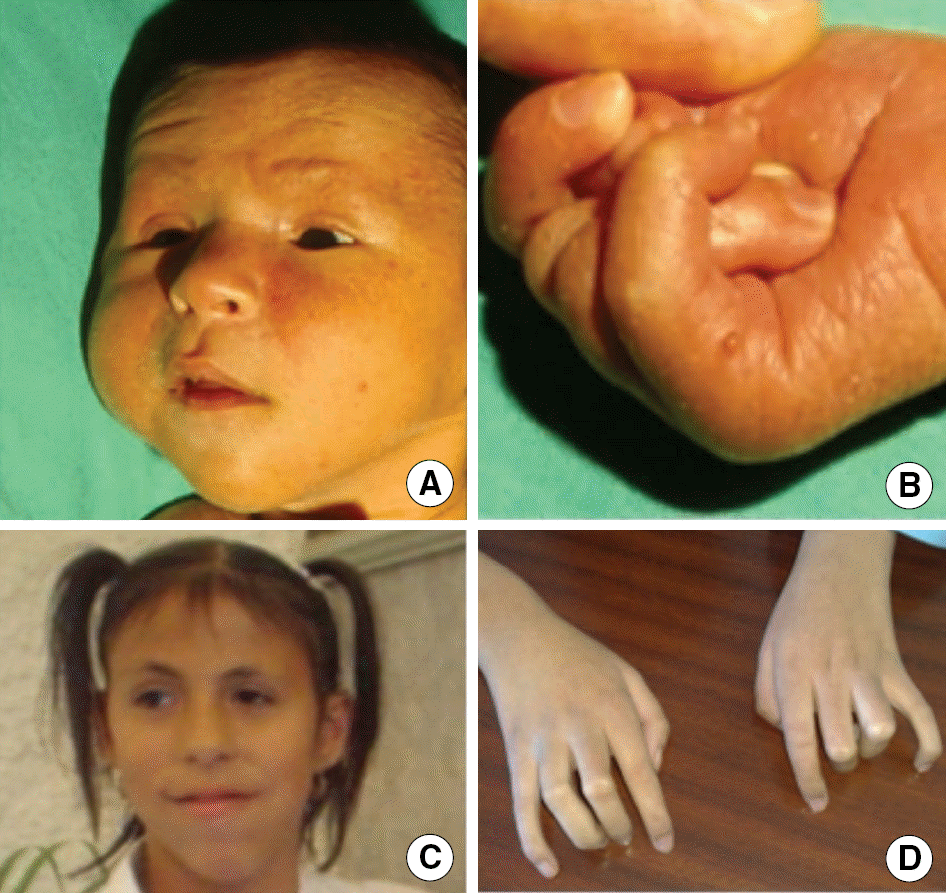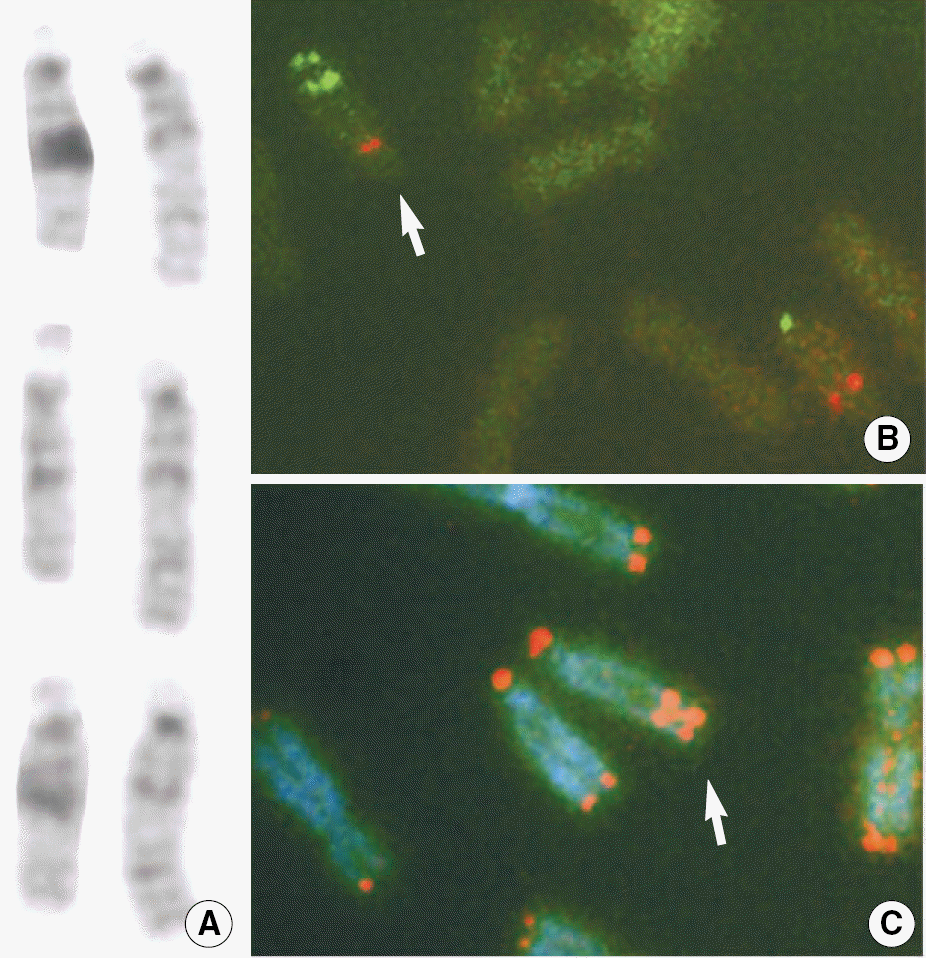Abstract
Distal 15q trisomy or tetrasomy is associated with a characteristic phenotype that includes mild to moderate intellectual disability, abnormal behavior, speech impairment, overgrowth, hyperlaxity, long face, prominent nose, puffy cheeks, pointed chin, small ears, and hand anomalies (mainly arachno- and camptodactyly). We present the case of a 13-yr-old girl with the main clinical features of 15q overgrowth syndrome and a 46,XX,dup(15)(q24q26.3)[117]/46,XX[3].ish dup(15)(q24q26.3) (SNPRN+,PML+,subtel++,tel++) de novo karyotype. The findings in this case are consistent with those in the previous distal 15q trisomy cases that presented with overgrowth and mental retardation. Further, the rearranged chromosome had a double set of directly oriented telomeric and sub-telomeric sequences.
Go to : 
REFERENCES
1.Fujimoto A., Towner JW., Ebbin AJ., Kahlstrom EJ., Wilson MG. Inherited partial duplication of chromosome No. 15. J Med Genet. 1974. 11:287–91.

2.Lacro RV., Jones KL., Mascarello JT., Jones OW., Wilson N., Jones MC. Duplication of distal 15q: report of five new cases from two different translocation kindreds. Am J Med Genet. 1987. 26:719–28.

3.Zollino M., Tiziano F., Di Stefano C., Neri G. Partial duplication of the long arm of chromosome 15: confirmation of a causative role in craniosynostosis and definition of a 15q25-qter trisomy syndrome. Am J Med Genet. 1999. 87:391–4.

4.Faivre L., Gosset P., Cormier-Daire V., Odent S., Amiel J., Giurgea I, et al. Overgrowth and trisomy 15q26.1-qter including the IGF1 receptor gene: report of two families and review of the literature. Eur J Hum Genet. 2002. 10:699–706.

5.Kim JH., Lee WM., Ryoo NH., Ha JS., Jeon DS., Kim JR, et al. A case of partial trisomy 15q25.3-qter. Korean J Lab Med. 2009. 29:66–70.

6.Tatton-Brown K., Pilz DT., Orstavik KH., Patton M., Barber JC., Collinson MN, et al. 15q overgrowth syndrome: a newly recognized phenotype associated with overgrowth, learning difficulties, characteristic facial appearance, renal anomalies and increased dosage of distal chromosome 15q. Am J Med Genet A. 2009. 149A:147–54.

7.James PA., Aftimos S., Oei P. Partial tetrasomy 15 due to a unique inverted triplication of chromosome15q24-q26. Am J Med Genet A. 2004. 130A:208–10.

8.Schluth C., Mattei MG., Mignon-Ravix C., Salman S., Alembik Y., Willig J, et al. Intrachromosomal triplication for the distal part of chromosome 15q. Am J Med Genet A. 2005. 136A:179–84.

9.Coco R., Penchaszadeh VB. Inherited partial duplication deficiency of chromosome 15 (p12;q22). J Genet Hum. 1978. 26:203–10.
10.Anneren G., Gustavson KH. A boy with proximal trisomy 15 and a male foetus with distal trisomy 15 due to a familial 13p;15q translocation. Clin Genet. 1982. 22:16–21.
11.Yip MY., Parsons A., Hulten M. A de novo tandem duplication 15 (q21 leads to qter) mosaic. Clin Genet. 1982. 22:1–6.
12.Chandler K., Schrander-Stumpel CT., Engelen J., Theunissen P., Fryns JP. Partial trisomy 15q: report of a patient and literature review. Genet Couns. 1997. 8:91–7.
13.Abe Y., Tanaka D., Soga T., Takeuchi T., Iikura Y. A case of de novo distal duplication of chromosome 15. Clin Genet. 2003. 63:76–8.

14.Okubo Y., Siddle K., Firth H., O'Rahilly S., Wilson LC., Willatt L, et al. Cell proliferation activities on skin fibroblasts from a short child with absence of one copy of the type 1 insulin-like growth factor receptor (IGF1R) gene and a tall child with three copies of the IGF1R gene. J Clin Endocrinol Metab. 2003. 88:5981–8.

15.Faivre L., Rousseau T., Laurent N., Gosset P., Sanlaville D., Thauvin-Robinet C, et al. Prenatal overgrowth and mosaic trisomy 15q25-qter including the IGF1 receptor gene. Prenat Diagn. 2004. 24:393–5.

16.Roggenbuck JA., Mendelsohn NJ., Tenenholz B., Ladda RL., Fink JM. Duplication of the distal long arm of chromosome 15: report of three new patients and review of the literature. Am J Med Genet A. 2004. 126A:398–402.

17.Bonati MT., Finelli P., Giardino D., Gottardi G., Roberts W., Larizza L. Trisomy 15q25.2-qter in an autistic child: genotype-phenotype correlations. Am J Med Genet A. 2005. 133A:184–8.

18.Kant SG., Kriek M., Walenkamp MJ., Hansson KB., van Rhijn A., Clayton-Smith J, et al. Tall stature and duplication of the insulin-like growth factor I receptor gene. Eur J Med Genet. 2007. 50:1–10.

19.Wechsler D. WISC-IV Wechsler intelligence scale for children. 4th ed.Mexico City: Manual Moderno;2005. :205. (Wechsler D. WISC-IV escala de inteligencia Wechsler para niños. 4th ed. Mexico City: Manual Moderno, 2005:205.).
20.Matute E., Rosselli M, et al. Child neuropsychological assessment. Mexico City: Manual Moderno-Universidad de Guadalajara-UNAM. 2007. (. Matute E, Rosselli M, editors. Evaluación neuropsicológica infantil-ENI.Mexico City: Manual Moderno-Universidad de Guadalajara-UNAM;2007.).
21.Lambert N., Nihira K, et al. AAMR Adaptive behavior scale-school. 2nd ed.Austin, Texas: Pro-ed;1993.
22.Nagai T., Shimokawa O., Harada N., Sakazume S., Ohashi H., Matsumoto N, et al. Postnatal overgrowth by 15q-trisomy and intrauterine growth retardation by 15q-monosomy due to familial translocation t(13;15): dosage effect of IGF1R? Am J Med Genet. 2002. 113:173–7.
23.Gratacos M., Nadal M., Martin-Santos R., Pujana MA., Gago J., Peral B, et al. A polymorphic genomic duplication on human chromosome 15 is a susceptibility factor for panic and phobic disorders. Cell. 2001. 106:367–79.

24.Zhu G., Bartsch O., Skrypnyk C., Rotondo A., Akhtar LA., Harris C, et al. Failure to detect DUP25 in lymphoblastoid cells derived from patients with panic disorder and control individuals representing European and American populations. Eur J Hum Genet. 2004. 12:505–8.

25.Genesio R., De Brasi D., Conti A., Borghese A., Di Micco P., Di Costanzo P, et al. Inverted duplication of 15q with terminal deletion in a multiple malformed newborn with intrauterine growth failure and lethal phenotype. Am J Med Genet A. 2004. 128A:422–8.
26.Sanlaville D., Baumann C., Lapierre JM., Romana S., Collot N., Cacheux V, et al. De novo inverted duplication 9p21pter involving telomeric repeated sequences. Am J Med Genet. 1999. 83:125–31.

27.Kotzot D., Martinez MJ., Bagci G., Basaran S., Baumer A., Binkert F, et al. Parental origin and mechanisms of formation of cytogenetically recognisable de novo direct and inverted duplications. J Med Genet. 2000. 37:281–6.

28.Petit P., Devriendt K., Vermeesch JR., De Cock P., Fryns JP. Unusual de novo t(13;15)(q12.1;p13) translocation leading to complex mosaicism including jumping translocation. Ann Genet. 1998. 41:22–6.
29.Fortin F., Beaulieu Bergeron M., Fetni R., Lemieux N. Frequency of chromosome healing and interstitial telomeres in 40 cases of constitutional abnormalities. Cytogenet Genome Res. 2009. 125:176–85.

30.Pujana MA., Nadal M., Gratacos M., Peral B., Csiszar K., Gonzalez-Sarmiento R, et al. Additional complexity on human chromosome 15q: identification of a set of newly recognized duplicons (LCR15) on 15q11-q13, 15q24, and 15q26. Genome Res. 2001. 11:98–111.

Go to : 
 | Fig. 1.Images of the patient as a newborn (A and B) and at 13 yr of age (C and D). (A) Note the sloping forehead, palpebral fissures oriented slightly downwards and outwards, bulbous nose with prominent bridge and septum, puffy cheeks, midline crease in the lower lip, and micrognathia. (B) Additional postaxial rudimentary digits and overlapping fingers in both hands. (C) Note the high forehead, elongated face, large nose, and pointed prominent chin. (D) Arachno-camptodactyly in both hands. |
 | Fig. 2.The patient's dup(15)(q24q26.3). (A) 3 G-banded chromosome 15 pairs with the duplicated homolog on the right. Note the distinct satellites on the normal member. (B) A partial metaphase after FISH with the dual-color Prader-Willi/Angelman (SNRPN) Region and 15q subtel clone 154P1 probe set labeled red and green, respectively; note the double 15q subtel green signal directly oriented. (C) A partial metaphase after FISH with the pantelomeric probe (red signal); note 2 signals in the same direct orientation. |
Table 1.
Cytogenetic and clinical findings in 16 patients with a “pure” distal 15q duplication∗
| Coco and Penchaszadeh [9] | Yip et al. [11] | Chandler et al. [12] | Abe et al. [13] | Okubo et al. [14] | Faivre et al. [15] | Roggenbuck et al. [16] | Bonati et al. [17] | Kant et al. [18] | Tatton-Brown et al. [6] | Present case | Distal 15q duplication [2-6] | ||||||
|---|---|---|---|---|---|---|---|---|---|---|---|---|---|---|---|---|---|
| Family A | Family B | ||||||||||||||||
| Case 1 Twin 1 | Case 2 Twin 2 | Case 3 | Case A | Case II-3 | Case III-2 | Case II-2 | Case II-6 | ||||||||||
| Sex/Age | M/20 mo | M/9 mo | F/13 yr 4 mo | F/9 mo | M/5 yr | M/22-wk fetus | F/1 d† | F/4 yr 6 mo | M/21 mo | M/4 yr 8 mo | F/3 yr 4 mo | F/adult | M/18 mo | F/38 yr | M/33 yr | F/13 yr 10 mo | |
| Duplicated segment | 15q22→qter | 15q21→qter | 15q24→qter | 15q24.3→q26.3 | 15q25→qter | 15q25→qter | 15q24→q26.3 | 15q24→q26.3 | 15q24→q26.3 | 15q25.2→qter | 15q26.1→qter | 15q26.1→qter | 15q26.1→qter | 15q26→qter | 15q26→qter | 15q24→qter | 15q2→qter |
| Rearrangement and occurrence | inv(15) (p1q22) mat | dir dup dn mosaic 46,XY | dir dup dn | dir dup dn | inv(15) (p11.2q25) mat | add (15) (p11)dn mosaic 46,XY | dir dup dn | dir dup dn | dir dup dn | add(15) (p11)dn | t(15;21) (26.1;p12) uk | inv(15) (p12q26.1) pat | inv(15) (p12q26.1) pat | t(14;15) (p11.2;q26) mat | t(14;15) (p11.2;q26) mat | dir dup dn mosaic 46,XX | Diverse |
| Mental or psychomotor retardation | + | + | + | + | + | NA | NA | + | + | + | + | NR | + | NR | NR | + | + |
| Defective speech | NA | + | NA | + | NA | NA | + | + | + | + | NR | + | + | + | + | + | |
| Height | <3 percentile | NL | <3 percentile | >97 percentile | >97 percentile | NR | <3 percentile | NL | >97 percentile | 97 percentile | >97 percentile | >97 percentile | >97 percentile | >97 percentile | >97 percentile | >97 percentile | |
| OFC | NL | <3 percentile | NL | >97 percentile | NL | Anencephaly | <3 percentile | <3 percentile | <3 percentile | 97 percentile | NR | >97 percentile | NL | NL | NL | >97 percentile | |
| Long distinctive face | + | - | + | - | + | NR | NR | + | - | - | + | + | Mildly dysmorphic | + | + | + | + |
| Prominent or bulbous nose | - | + | - | - | - | NR | NR | - | + | - | + | + | - | + | + | + | + |
| Pointed or prominent chin | - | - | - | + | NR | NR | - | - | - | - | + | + | + | + | + | + | |
| Puffy cheeks | NR | + | - | + | + | - | NA | + | - | NR | - | + | - | + | + | + | + |
| Congenital heart disease | - | Hypertrophic ventricular septum | Patent ductus arteriosus | Patent ductus arteriosus | NR | NR | NR | - | VSD and ASD | NR | NR | - | - | - | - | + | |
| Renal anomalies | NR | - | Horseshoe | - | - | NR | NR | - | - | - | NR | Horseshoe | Right agenesis | - | - | - | + |
| Abnormal fingers | Short, stubby | Brachydactyly | Arachnodactyly | Syndactyly | NR | NR | NR | Syndactyly, long tapered fingers and incurved toes | Clinodactyly | NR | NR | NR | Tapered fingers, overlapping toes | Clinodactyly, overlapping toes | NR | Poly, arachno, and camptodactyly | + |




 PDF
PDF ePub
ePub Citation
Citation Print
Print


 XML Download
XML Download